Table of Contents
Bala Shark Overview
The colorful Balantiocheilus melanopterus, commonly known as bala shark, is a colorful and shark-like freshwater fish that is becoming more and more popular among hobby aquarium owners. It originates from certain areas in Southeast Asia and belong to the Cyprinidae family, and they are a fun addition to a tank that needs a little more life brought into it. While not too difficult to care for, the owner of a bala shark needs a decently sized tank that can hold such a large fish, but if you do have the right tank size – the bala shark is a fish you won’t regret adding to your large aquarium.
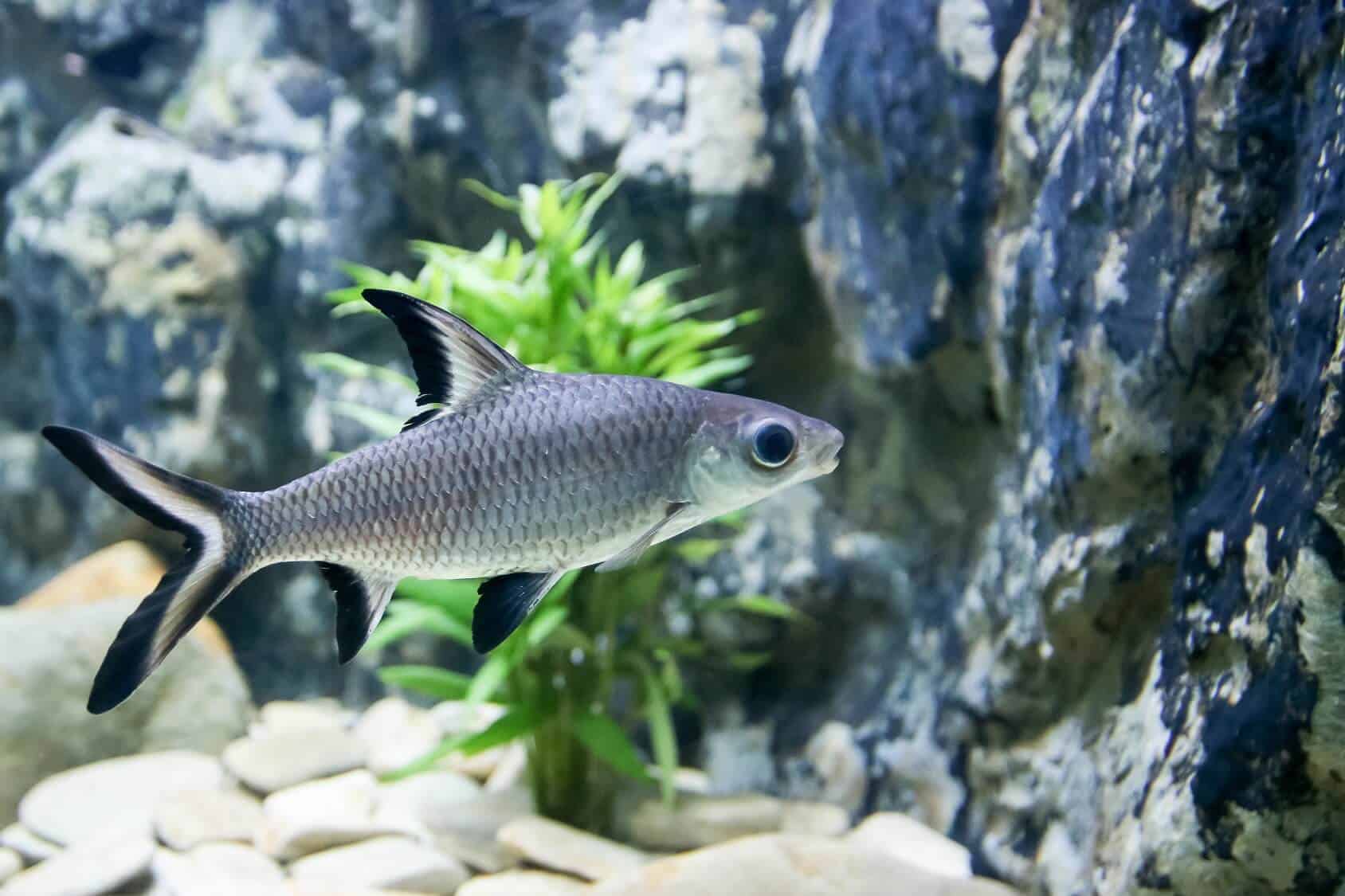
If you want an aquarium fish that stands out and that takes the look of your tank to the next level, and if you have the space for it, then you should definitely consider a school of bala sharks.
Bala Shark Basic Information
It is a quick introduction to the Bala shark, with all the basic facts you need to know about this freshwater fish. Bala sharks are colorful, peaceful, and an excellent addition to any 120-gallon tank or bigger, and they adapt well to most types of aquariums, provided they are of a decent size for larger fish.
All this information will show you that a Bala shark requires standard care, but they do need additional space, and you also need to take into consideration that they can live for a total of 10 years. Do you have a tank the right size, and are you willing to provide for your fish for what could potentially be very many years? If the answer is yes, then you have just taken the first step towards owning a stunning fish with a striking shark resemblance.
The below information will help you figure out if a Bala shark could be the right fish for your tank:
| Information chart | Bala shark |
|---|---|
| Scientific name | Balantiocheilos melanopterus |
| Family | Minnows and Carps |
| Care level | Low |
| Temperament | Timid |
| Color | Yellow, black, and grey |
| Lifespan | 10 years |
| Size | 30 cm |
| Diet | Accepts flake foods, pellets, freeze-dried and frozen foods |
| Minimum tank size | 125 gallons |
| Temperature | 22–28 °C |
| Water conditions | 6.0–8.0 pH |
| Tank mate compatibility | Barbs and rainbowfish |
Bala Shark Appearance
The long body and the triangular dorsal fin are two giveaway signs of dealing with a Bala shark. It has several names such as silver shark, tricolor shark, and more, and they have a metallic color that stands out while it swims around in the water. The scales on their bodies are very prominent, with a yellow tail, large bulging eyes, and fins with black tips. There are color variations as well, but this is a fish that is generally very easy to recognize if you have some basic knowledge about the species.

Their adult size is generally somewhere around 13 inches, and it is an active fish that needs a tank where it can swim around and exercise. It is mostly the shape of the body and that triangular dorsal fin that has given it its name (due to the features being considered shark-like), but the large and colorful fins give the Bala shark a unique identity that is about as far from an actual shark as you can come.
The contrast of that missile-shaped silver body and the yellowfins makes it a sight for the eye in any tank.
When you purchase one of these from a pet store, they will often be quite young still and may only measure about 3-4 inches, and this leads many people to believe that any tank will do and that they are a fish that won’t grow much at all. Don’t fall into this trap, as the silver bala needs a big tank and plenty of space.
Both male and female Bala sharks look very similar, and it can be very difficult for a beginner or an amateur to distinguish the sex of one of these. Some species will have differentiating colors depending on whether they are male or female, but this is not the case with the Bala shark.
The Lifespan of Bala Shark
The typical lifespan of a Bala shark is known to be 10 years. But their life expectancy greatly depends on the care. So, if you offer them proper care, the fish can outlive this expected span. Otherwise, it can die earlier as well.
Bala Shark Size
The typical Bala shark can typically grow up to 10 inches on the lower end and 14 inches for the larger specimens.
/Balantiocheilus_melanopterus_C_E_Timothy_Paine-56a32fd05f9b58b7d0d0df7f.jpg)
Natural Habitat and Origin
As far as the natural habitat of the Bala shark is considered, they are known to live in the depths of large and medium-sized-rivers. Naturally found in the rivers and lakes of Southeast Asia.
Interestingly, Bala sharks prefer to live in clean fast-flowing waters. It is the main reason you will find them in the middle regions rather than the top or the bottom. Also, it spends most of its time swimming around.
Talking about the origin, this fish is known to come from the Malay Peninsula, Sumatra, and Borneo.
While the name indicates that you are dealing with a shark, the balantiocheilus melanopterus is just a fish that strongly resembles a shark, but this has done nothing to stop its popularity from spreading. We say that it was a native to these areas, in the past tense, because the wild population has been drastically reduced over recent years.
Some even argue that these sharks seem to have become completely extinct in some areas where they would once thrive. The reason for this has not been determined, and it is possible that it could be a result of contamination or overfishing.
The Bala shark can be found on the IUCN Red List of Threatened Species, and it has been listed since 1996, and as a result, most Bala sharks you see in aquariums today were born in captivity and farm bred. It is the reason why you can own one despite their endangered status, as they are only threatened as a species in the wild, but there is plenty of farm-bred fish destined for the aquarium business.
Its popularity as an aquarium species has increased steadily over recent years, and it is not hard to see why when you spot one in an aquarium for the first time. It is an impressive fish with that shark look, without actually being a shark, and it is surprisingly easy to care for considering it being on the larger side.
Bala Shark Care and Tank Set-Up
Bala sharks are omnivores, which means that they eat both other animals and plants, and the truth is that these fish are likely to consume anything you put in the tank, provided it is edible. They are not picky, so it will be up to you to make sure you give them a nutritious diet. The good idea is to feed high-quality flakes as the main meal and let them have live food such as shrimp a couple of times a week.
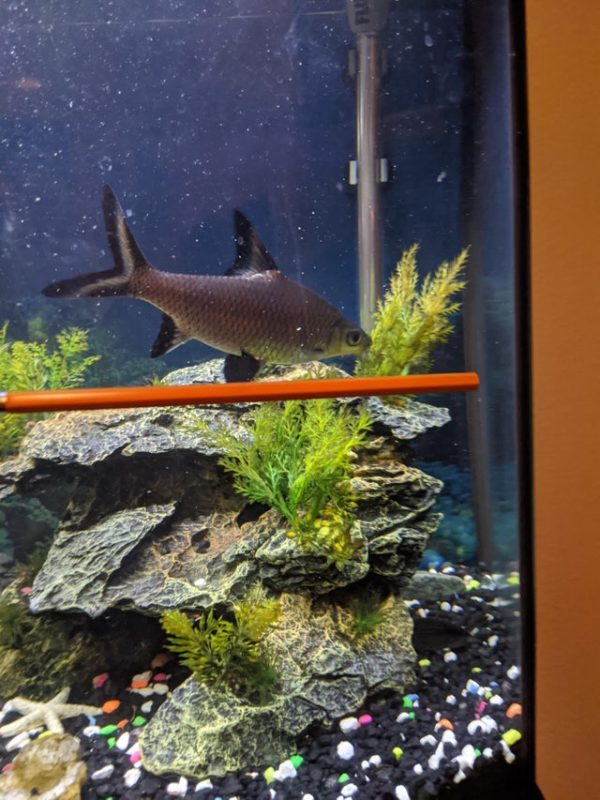
As for the Bala shark’s diet and feeding instructions, this is a fun fish to feed just because it can get so excited! Many experts recommend feeding Bala sharks two times per day instead of just doing one daily feed. It is because the fish tends to overeat if given a chance, and their metabolism should have their daily food intake split in two. If you can allow your Bala shark to eat more than once a day – do so, as it will likely help maintain your swimming pet healthy for a lot longer. A happy and healthy shark will live a longer life, and an adequate diet plays a big role in their overall wellbeing.
Tank Conditions
It is advisable to get a long tank for Bala sharks for the simple reason that they like to swim, and if you plan to keep a school of four fish – you need a tank that can hold at least 120 gallons of water. After all, the adult size of one of these Bala sharks is 13 inches. Another good idea is to keep an aquarium cover on the tank, as this gorgeous silver shark tends to jump straight out of the tank when (and if) they get scared. You don’t want to come home and find your tricolor shark lying there on the floor.
The next step is to decorate with appropriate plants, and you will want to make sure that you don’t add plants that take up too much space. Why? Because the Bala shark needs to be able to swim.
One thing you can do is to use plants that cover the surface of the water without covering too much at the bottom, as these will work as a natural cover to prevent your Bala sharks from accidentally jumping out of the water. Driftwood and large rocks are other good additions you can use to make your tank feel more like home to the Bala shark.
Bala sharks are very sensitive to drastic temperature changes in the water, and they don’t do well with very low temperatures. In fact, this could result in them developing something known as white spot disease.
Keep the water temperature somewhere between 72 and 82 degrees Fahrenheit. The best way to keep these swimmers from getting diseases is to keep the water as clean as possible and provide an environment where they do not experience stress, anxiety, or distress.
Bala Shark Tank Size and Specifications
This section covers the size, shape, filter type, and more information.
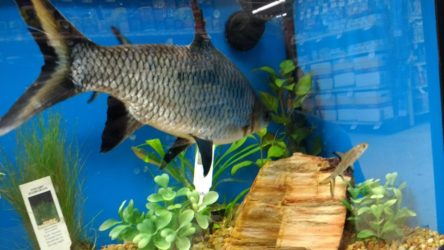
Optimum Tank Size for Bala Shark
The recommended tank size for Bala sharks is 125 gallons. That’s because this fish species can outgrow so many tanks. After all, it keeps growing for years.
Tank Shape for Bala Shark
Bala shape is not a shark. It only resembles the shark’s appearance. It has a torpedo-shaped body and a large triangular-shaped dorsal.
While the exact tank shape for the Bala shark is debatable, it’s suggested to pick a rectangular tank with no less than 120 gallons.
Filter Type
If you are housing a Bala shark, you need to install a good-quality filter to the tank. Use a good filter to perfectly mimic the fish’s natural living habitat.
Substrate
A thing to note about Bala sharks is that they do not swim at the bottom of the tank. That means you don’t necessarily have to use any specific kind of substrate. But if you want to offer them better-living conditions, you can add dark-colored pebbly substrate.
How Many Bala Shark in 125 Gallons
If you are housing a Bala shark, you can keep around 5 fish in one tank.
Water Parameter for Bala Shark
Water Temperature
The ideal water temperature for a Bala shark is 22–28 °C (72–82 °F).
pH Level
The perfect pH level for the Bala shark tank is 6.0–8.0.
Water Hardness
The ideal water hardness for the Bala shark tank is (5.0–12.0 dGH), i.e., soft to medium.
Bala Tank Landscape
To set up a Bala shark tank, you need around 125 gallons. Since Bala sharks are great swimmers, they like to live in a big aquarium.
Moving to the substrate, you don’t need to add any special kind of substrate as this fish does not swim at the bottom of the tank.
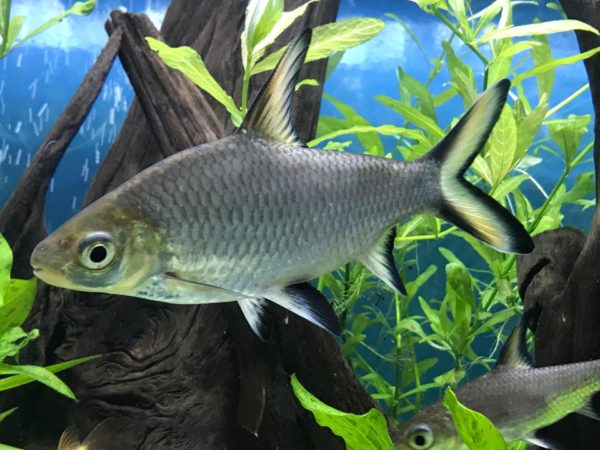
Best Plant for Bala Shark Tank
Bala sharks can live comfortably with almost all the plants. Thus, you can add plants like anubias but make sure that it doesn’t block direct sunlight to the tank to impact the Bala shark’s growth.
Worst Plant for Bala Shark Tank
Avoid adding small plants to the tank as Bala sharks are known to feed on plants.
Decorations for Bala Shark Tank
You can add several decorative items to your Bala shark tank. That’s because this fish species is timid. So, multiple decorative items act as a hiding spot for them.
Lighting for Bala Shark Tank
If you are planning to keep Bala shark, you should offer around 8 hours of lighting. For better growth, you can keep a day-night lighting cycle.
Feeding Bala Shark
Best Diet for Bala Shark
Bala shark is one of the easiest fish to take care of. As far as their dietary requirements are considered, flake foods, pellets, freeze-dried and frozen foods. You can also feed them live foods, including Daphnia, bloodworms, brine shrimp, mosquito larvae, and tubifex worms.
How Often Should You Feed a Bala Shark?
You must feed a Bala shark thrice a day.
Bala Shark Behavior and Temperament
Bala sharks are very calm, and they rarely cause trouble in the tank. They may be a little shy after you first bring them home, and you may notice them hiding for a few days, but this is not an indication of it being a shy fish.
With time they will become more confident, and you will be able to observe them swimming fast through the water. They do not have the personality of sharks, and the name is only based on their look, and aggression is not a trait associated with the balantiocheilos melanopterus.
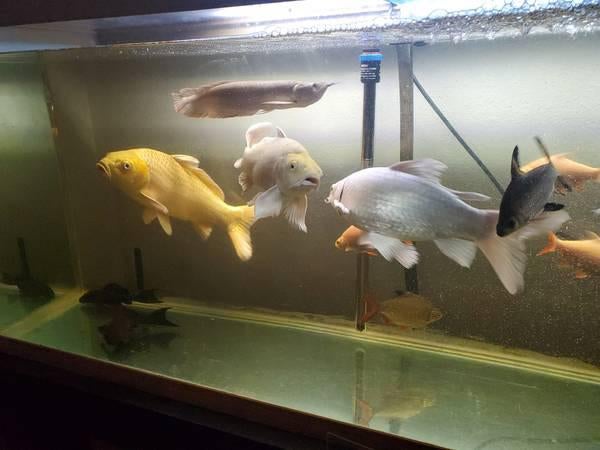
That said, if you have small fish swimming around in your tank water as well, there is always a risk of the Bala shark deciding to eat it. They are omnivores, after all, and tend to eat whatever comes in their way.
The silver ball shark thrives when living together with 3, 4, or more other Bala sharks and is not a fish that should be kept on its own as they are very social and outgoing.
Just like some other larger species, these do scare quite easily, which could cause them to jump straight up or ram into other inhabitants in the tank, and it is something to keep in mind so that you can try and place your aquarium in a calmer part of the house where the Bala shark is less likely to scare.
These episodes generally do not last long, and provided it does not hurt itself – your Bala shark will soon be back to its normal self, swimming vigorously through the tank water.
Are Bala Shark Lone or Societal or Lone in Nature?
Bala shark likes to live in the school. You can add around four or more fish to the tank.
Bala Shark Suitable Tank Mates
Ideal Bala Shark Tank Mates
Bala shark silverfish do best with other Bala sharks, and being schooling fish – four or more is a good number. Keeping less than four could result in some unhealthy bullying becoming a problem in the tank, and too many are only too many if you don’t have a tank the right size. These are big fish, and they need their space.

A Bala shark that is kept alone in a tank may eventually start displaying signs of being depressed, jumpy, and overall unhappy, and it is just not a healthy environment for them to live in.
Other peaceful fish of a similar size could also make good tank mates, and the Bala shark makes a good community tank fish as long as there is enough space. You should avoid having small fish like tetras in the same tank as the Bala shark might eat them, and any type of shrimp or vertebra is also a bad idea due to this being a part of a Bala shark’s natural diet.
Choose thank mates wisely, and you might want to avoid adding fish that scare easily as the Bala shark tends to swim around fast and vigorously, which could startle some species.
Bad Bala Shark Tank Mates
You must avoid adding fish to the bigger tank because the Bala shark will get intimidated.
Breeding Bala Shark
While some claim to have bred these fish in an aquarium, it has not been documented or proved and is considered to be highly unlikely. An aquarium simply does not give the fish what it needs to breed, and instead, most Bala sharks are bred in fish farm facilities, mainly in Asia.
The reason why they are so difficult to breed yourself in your aquarium is likely to have to do with fish tank size and possibly the water quality, so if you had hopes of breeding Bala sharks – you are unfortunately up for a bit of disappointment.
Males and females can also be difficult to distinguish when it comes to ball sharks, as they tend to look very similar. When the female is ready for breeding, her body might become slightly plumper, but due to the lacking conditions in an aquarium – this is likely not something you will ever get to see.
Some do claim to have done it successfully, though, so if you are eager to give it a try, make sure you set up a separate breeding tank for the fry. If you were to be successful, the best strategy is to remove the adult Bala sharks from the water to prevent them from eating their own offspring. That said, you do have to be prepared for failure due to the complicated breeding nature of the Bala shark.
Bala Shark Breeding Level
Breeding Bala sharks is not easy.
Bala Shark Sexual Dimorphism
To distinguish between male and female Bala sharks, you can see their size. The female Bala shark is considerably shorter than males.
Bala Shark Common Disease and their Treatment
Bala sharks do not fall sick easily. But they are likely to develop certain health complications like dropsy. It happens due to poor tank health. So, if you want to protect your fish from developing this issue, you should keep the tank clean.
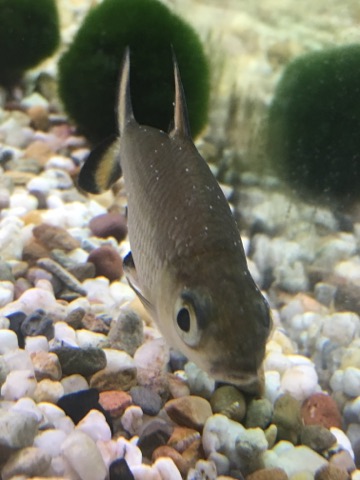
Facts About Bala Shark
- Bala shark likes to live in school
- They do not have many maintenance needs
- Breeding them is not easy
Is Bala Fish Right for you?
If you are a beginner, you can consider keeping ala fish in the tank. When you have them in the tank, try to add several decorative items as they act as hiding spots.
Frequently Asked Questions (FAQs)
The more you know about this fish before you make the decision to bring one home, the better care you’ll be able to provide it with. The Bala shark is a visually stunning aquarium fish, and it is no wonder its popularity has peaked. And below, you will find some of the most commonly asked questions about the breed.
Are Bala sharks aggressive?
This fish is not usually aggressive and will almost always live in perfect peace and harmony, provided it has sufficient space to swim around and appropriate tank mates.
How big do Bala sharks get?
An adult Bala shark can grow to be approximately 13 inches. When purchasing one at the pet store, it is essential to consider this as they are often significantly smaller (and younger) when sold.
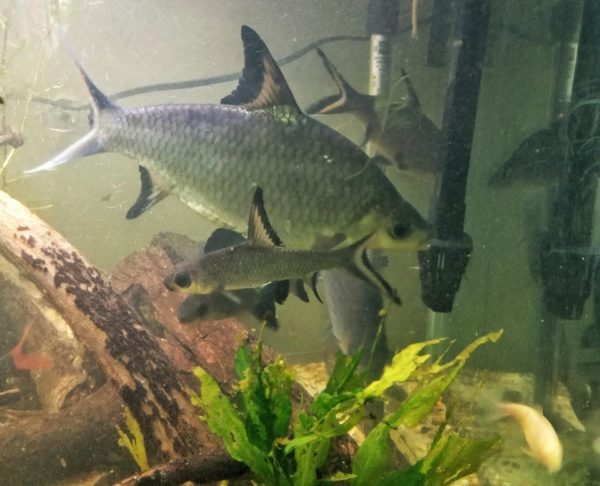
Which fish can live with Bala sharks?
Preferably fish of the same species and a similar size, and you should make sure to choose only other peaceful fish when the plan is to add them to the same water.
What do Bala sharks eat?
The simple answer is that this fish eats everything, and they tend to be very enthusiastic about being fed! They eat live food like brine shrimp, bloodworms, other small animals, flakes, and plant-based food.
Conclusion
It is not a fish for everyone, and you can’t expect to keep one in a regular-sized tank, as this would both be cruel and unhealthy for such a large fish. On the other hand, the care it requires is quite basic, so as long as you have a big tank, you should be fine even if you are a beginner. The more you know about the Bala shark before you bring one home, the easier it will be both for you and your new fish to adjust. It will also help you have realistic expectations regarding your latest aquarium addition.
